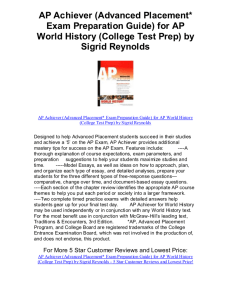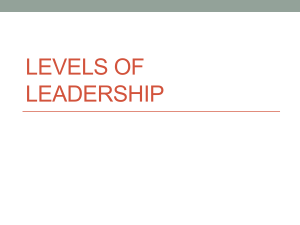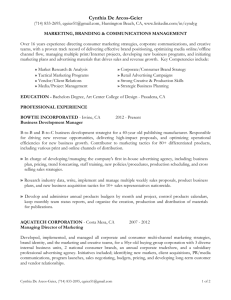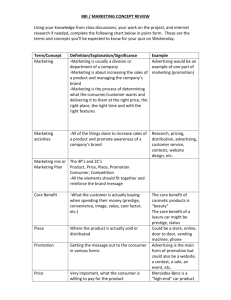2013
advertisement
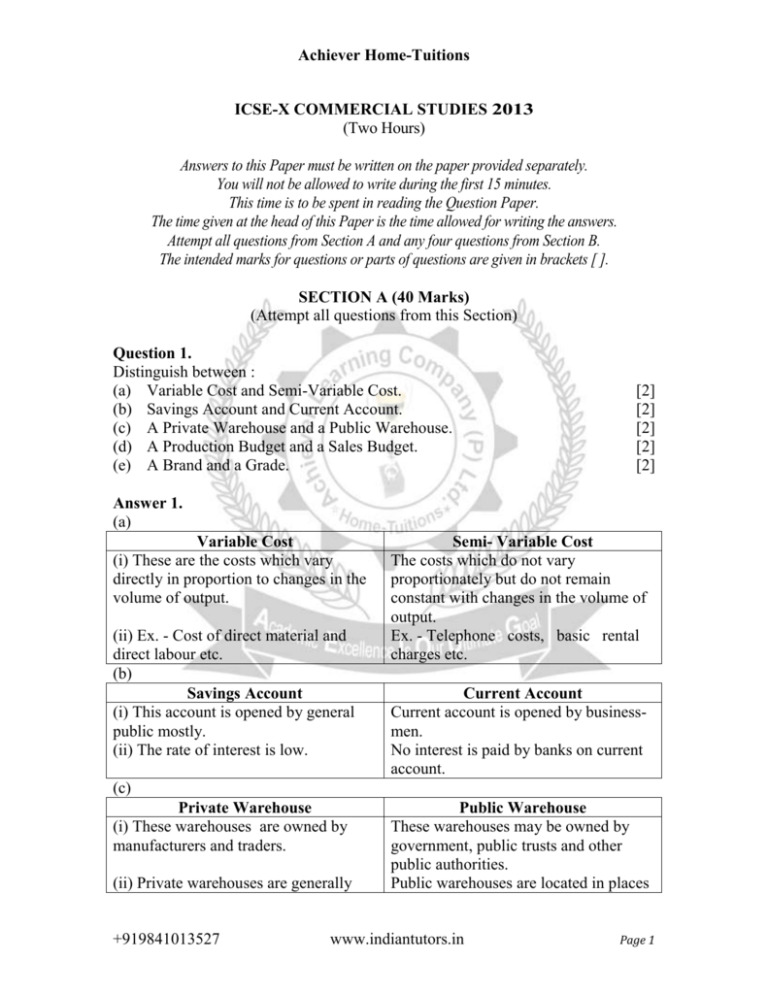
Achiever Home-Tuitions ICSE-X COMMERCIAL STUDIES 2013 (Two Hours) Answers to this Paper must be written on the paper provided separately. You will not be allowed to write during the first 15 minutes. This time is to be spent in reading the Question Paper. The time given at the head of this Paper is the time allowed for writing the answers. Attempt all questions from Section A and any four questions from Section B. The intended marks for questions or parts of questions are given in brackets [ ]. SECTION A (40 Marks) (Attempt all questions from this Section) Question 1. Distinguish between : (a) Variable Cost and Semi-Variable Cost. (b) Savings Account and Current Account. (c) A Private Warehouse and a Public Warehouse. (d) A Production Budget and a Sales Budget. (e) A Brand and a Grade. [2] [2] [2] [2] [2] Answer 1. (a) Variable Cost (i) These are the costs which vary directly in proportion to changes in the volume of output. (ii) Ex. - Cost of direct material and direct labour etc. (b) Savings Account (i) This account is opened by general public mostly. (ii) The rate of interest is low. Semi- Variable Cost The costs which do not vary proportionately but do not remain constant with changes in the volume of output. Ex. - Telephone costs, basic rental charges etc. Current Account Current account is opened by businessmen. No interest is paid by banks on current account. (c) Private Warehouse (i) These warehouses are owned by manufacturers and traders. (ii) Private warehouses are generally +919841013527 Public Warehouse These warehouses may be owned by government, public trusts and other public authorities. Public warehouses are located in places www.indiantutors.in Page 1 Achiever Home-Tuitions located in rural and sub-urban areas. linked to roads, railways and water ways. (d) Production Budget (i) Production budget contains an estimate of the total volume of production. (ii) The works manager is responsible for the preparation and execution of the production budget. (e) A Brand A brand is a name, term, symbol or design used to identify the goods or services. Sales Budget Sales budget is a forecast of sales to be achieved during a specified period in future. The sales manager is directly responsible for this budget. A Grand A grade is a' division of products into class made up of units possessing similar characteristics of size and quality. Question 2. (a) Give any two methods used for On-the-Job training. (b) Explain 'Indirect Cost'. (c) Why is gratuity given by an employer to an employee ? (d) What is a Trademark ? (e) Give two examples of efficient and eco-friendly technology. [2] [2] [2] [2] [2] Answer 2. (a) Two methods used for on-the-job training are : (i) Job Rotation : This method involves the movement or transfer of the trainee from one job to another, basically of similar nature, either in the same department or different departments. The trainee gets job knowledge and gains experience in different assignments. (ii) Apprenticeship Training : In this method, the trainee learn by working with those who are already skilled in their jobs. People who want to enter skilled traders (such as welder, plumber) are required to undergo apprenticeship training. (b) Indirect cost refers to the expenses incurred on those items which are not directly chargeable to production. Salaries of timekeeper, storekeeper, foremen are examples of indirect costs. (c) Gratuity is an extra-gratia or voluntary payment made by an employer to his employees who retired after long and dedicated services. It is given to protect the superannuated employee against the risk of old age. (d) A trade mark is a legal term and refers to the brand which is registered under the Trade and Merchantile Marks Act, 1958. +919841013527 www.indiantutors.in Page 2 Achiever Home-Tuitions (e) Two examples of efficient and eco-friendly technology are : (i) Bio-technology : It means using living organisms or their products for commercial purposes. (ii) Nano-technology : It is the development and use of devices that have a size of only a few meters. Question 3. (a) State two expectations of Competitors or Associates from a business concern/enterprise. [2] (b) Give any two suggestions to draw the attention of viewers to an advertisement of a product/service marketed by your company. [2] (c) Briefly explain the concept 'Marketing Research'. [2] (d) What is meant by 'the Clearing House Function' of the Reserve Bank of India ? [2] (e) Explain the term Brand Equity. [2] Answer 3. (a) Two expectations of competitors from a business concern are : (i) Fair trade practices regarding price, quality and service. (ii) An atmosphere of healthy competition and ethical behaviour. (b) Two suggestions to draw the attention of viewers to an advertisement are: (i) By using picture and drawings of the products being advertised. (ii) By using catchy but short headlines. The headlines may be slogan or reference to the quality of the product. (c) Marketing research is "the systematic gathering, recording and analysis of data about marketing problems to facilitate decision-making." Marketing research provides information which is very helpful in taking right decisions, about the various elements of marketing mix, i.e., product, price, place and promotion. (d) The Central Bank provides clearing house facility to the commercial banks. It settles the claims of commercial banks through a process of book entries. The daily balances between the commercial banks can easily be adjusted by means of debit and credit entries in their respective accounts with the Central Bank. (e) Brand equity means the marketing effect of a brand. It refers to the outcomes from the marketing of a particular product or service because of its brand name. Question 4. (a) Distinguish between a Debit Card and a Credit Card. (b) State any two rights of a Consumer. +919841013527 www.indiantutors.in [2] [2] Page 3 Achiever Home-Tuitions (c) Write a short note on the Chipko Movement. (d) What do you understand by Audio-Visual Communication ? (e) State two advantages of Road Transport over Air Transport. , [2] [2] [2] Answer 4. (a) Debit Card (i) In case of debit card, card holder must have money in his/her bank account (ii) With debit card the card holder uses his own money. Credit Card In case of credit card the balance in account is not necessary. With credit card the account holder is provided credit by the bank for a maximum period of 52 days. (b) Two rights of a consumer are : (i) The right to choose : The consumer should be assured access to a variety of goods at competitive prices. This means the seller should not use aggressive selling techniques to sell the product to the consumer. There should be freedom to choose from alternative products. (ii) The right to safety : These are various risks involved in the consumption and use of products such as food drugs, toys, electrical appliances etc. The consumers have the right to get protected against such risks. (c) Chipko Movement was led by a group of villagers in the Uttarakhand region in 1970. They opposed commercial logging. The movement is known for its tactic of hugging trees to prevent them from being cut down by the contractors. This movement draw worldwide attention. It inspired environmentalists both nationally and globally. (d) Audio-Visual communication combines both sound (aural) and sight (visual) means. The communication which are seen and heard both. Example television. (e) Two advantages of Road Transport over Air-Transport are : (i) Economy : For short distances and small loads, road transport is quicker and economical compared to air-transport. (ii) Door to door services : Road transport provides complete service by loading the goods at the consignor's door and unloading them at the consignee's place. Goods can be loaded wherever they are and can be taken directly to their destination while in air transport it is not possible. +919841013527 www.indiantutors.in Page 4 Achiever Home-Tuitions SECTION B (40 MARKS) Attempt any four questions from this Section Question 5. (a) Differentiate between Shareholders and Creditors as Stake holders of a commercial organisation. [5] (b) Distinguish between oral communication and written communication. [5] Answer 5. (a) Creditors (i) Shareholders are the owners of the company. (ii) Shareholders earn profit. (iii) They have the voting right. (iv) They are internal stake-holders. (v) They invest in the capital of the company. (vi) They assume greater risk of loss of capital. Shareholders Creditors are the lenders to the company. Creditors take interest from the company. Creditors don't have any voting right. They are external stake-holders. They only give loan to the company. They assume lesser risk of loss of loan. (b) Oral Communication 1. It is a transmission of a message through written words. 2. Permanent record for future references. 3. In appropriate for urgent messages. Written Communication It is a transmission of a message through spoken words. No record for future reference. Appropriate during emergent situations. 4. Takes more time. Takes less time. 5. More economical for distant places. Not economical for distant places. Question 6. (a) How can environmental values and ethics be protected ? Give reasons to support your answer. [5] (b) Explain the different sources of Internal Recruitment. [5] Answer 6. (a) Environmental values make people environmentally conscious. Teaching environmental values encourages people to carry cloth bags. Use organic manure, keep surroundings clean, refuse use of polybags etc. The following steps can be taken : +919841013527 www.indiantutors.in Page 5 Achiever Home-Tuitions (i) Develop suitable literature in the form of comics, slogans, charts and other child friendly materials. (ii) Compile short stories having strong value components. (iii) Develop literature on human values for teachers. (iv) Develop audio and video programmes both for teachers and students. (v) Design special literature for parents. (vi) Develop syllabi of all subjects to inculcate right values. (vii) Create awareness among all so that everyone has a sacred duty to protect the environment. (b) Under internal sources of recruitment, the vacant job positions are filled by including the existing employees of the organisation. The different sources of Internal Recruitment are : (i) Promotions : Vacancies at higher levels may be filled up by promoting persons working at lower levels. It involves shifting an employee to a higher post carrying a higher status and increased salary. (ii) Transfer : Transfer means shifting an employee from one factory, branch or office to fill vacancy in another factory, branch or office of the company. It involves shifting an employee to a similar job without change in status and salary. (iii) Employee Referrals : Present employees of the company provide information about the candidates who are willing to be considered for the present vacancies. (iv) Former Employees : These include retired employees who are willing to work on a part-time basis, individuals who left work and are willing to come back for higher compensations. Even retrenched employees are taken up once again. (v) Internal Notification : Management issues an internal notification for the existing employees to apply for the vacancy in the company. Question 7. (a) Explain the Experimentation method of Marketing Research. (b) 'Budgets are very useful in Management'. Justify. [5] [5] Answer 7. (a) Under the experimentation method of Marketing Research, a control market is established in which all forces except those being tested are kept under check. Reactions are recorded under controlled conditions to test a theory. Experimental method provides lessons which can be used to make large scale marketing activity more effective and profitable. This method is realistic as it simulates the actual market situation. Mathematical models can be used for measuring the data in quantitative terms. However, this method involves a large expenditure of time and many. It requires skilled investigators. +919841013527 www.indiantutors.in Page 6 Achiever Home-Tuitions Moreover, it is difficult to select test markets and to control the variables. (b) Budgets are very useful in management. They offer the following advantages: (i) Sound planning : Budgets make planning purposeful and precise. Objectives and programme are expressed in physical or monetary units in budgets. Budgets are prepared on the basis of forecasts therefore budgets force managers to think about the future. (ii) Higher efficiency : Budgets bring efficiency and economy to the working of a business firm. They help management in obtaining the most profitable combination of different factors of production. (iii) Sense of responsibility : Budgets help to establish divisional and departmental responsibility. They prevent "buckpassing" and create a sense of responsibility among managers. (iv) Source of motivation : Budgets represent the 'milestones' to be reached. They tell people what is expected. Budget become the goals to be attained. (v) Co-ordination : Budgets force executives to think as a group. Budgets are prepared in consultation with one another. Therefore, they help in achieving coordination between different departments of the enterprise. (vi) Delegation of authority : Budgets allow delegation of authority without loss of control. It permits participation of employees at all levels. Question 8. (a) Distinguish between the Principle of Indemnity and the Principle of Insurable Interest. [5] (b) Explain the role of Commercial Banks in the Economic Development of a country. [5] Answer 8. (a) Indemnity means promise to compensate in case of loss. The object of every insurance contract is to place the insured as nearly as possible in the same financial position after the loss as he was before the loss. The insured is entitled to recover from the insurer only the amount of loss actually suffered. The maximum amount of compensation will be upto the sum insured or the value of the policy. While principle of Insurable Interest says that in the absense of insurable interest, a contract of insurance becomes a wagering contract which is null and void and unenforceable at law. Insurable interest means that the insured must be in such a position that he will suffer a primary loss by the happening of the event insured against. A person is said to have an insurable interest in the subject matter insured, if he is benefitted by its existence and suffers a loss by its destruction. (b) Banking is the lifeline of an economy and business activities cannot operate +919841013527 www.indiantutors.in Page 7 Achiever Home-Tuitions smoothly without banking services. According to Stephenson, "Banks are the distributors and protectors of the liquid capital which is the life blood of any notion." (i) Safety of money : Money deposited in a bank remains safe. Precious articles too can be kept in the safe custody of banks in locker. (ii) Increase in credit: Customers with bank accounts enjoy better credit worthiness in the business world. Banks also provide credit to their customers. (iii) Savings : Banks encourage the habit of saving and thrift among people. They mobilise public savings and invest them in productive avenues. They increase the rate of capital formation in the country. (iv) Transfer of money : Banks provide convenient and safe means of sending money from one place to another. Moreover, payment through cheques provide a legal proof to the transaction. (v) Collection of money : Banks collect and realise the bills, interest etc. on behalf of their customers. Question 9. (a) Briefly explain any five factors a businessperson would consider while selecting an appropriate media to advertise his/her product. [5] (b) What do you understand by 'Group Insurance' ? State any three features of Group Insurance. [5] Answer 9. (a) The success of an advertising campaign depends to a great extent upon the media. Therefore, due care should be taken in selecting the media of advertising. While choosing the appropriate advertising media, following factors should be kept in view : (i) Nature of the product : The product to be advertised is the main determinant of the advertising medium. Consumer products such as toothpaste, cold drinks, soap etc. are meant for the masses and therefore should be advertised through newspapers, radio, films and outdoor displays which have a general and wide appeal. On the other hand, industrial goods like raw material, machinery, etc. can be advertised better in specialised trade professional journals, etc. (ii) Nature and size of the market : The geographical location or region, size of population and its purchasing power have an important bearing on advertising media. Advertising in local markets can be done profitably through local newspapers, film and outdoor displays. Magazines and direct mail are more appropriate media for advertising in national and international markets. (iii) Objectives of advertising : When a new product has to be introduced, a +919841013527 www.indiantutors.in Page 8 Achiever Home-Tuitions combination of various media may be used. Prize contests and exhibition may be used profitably to build up goodwill and increase sales. (iv) Type of audience : Illiterate and poor people can better be approached through radio, films and television. Newspapers, magazines, outdoor displays and direct mail may be used to convey the message to educated and well to do customers. (v) Circulation of media : Newspapers and other media having wide circulation are useful where the message is to be conveyed to a very large number of people. Magazines, direct mail and other media having limited or selected circulation carry the message to a limited number of people. (b) Group insurance is a scheme which provides insurance cover on the lives of several persons under one insurance policy or contract. It is generally provided to the employees working under one employer. Features of group insurance are as follows : (i) Insurance is provided to all employees without any evidence of insurability. (ii) It provides risk coverage to the employees as long as they remain in the service of the employer. (iii) The premium is generally paid jointly by the employee and the employer. Question 10. From the following Trial Balance ofShri Rai Bahadur, prepare Trading, Profit & Loss Account for the year ending 31st March, 2012 and Balance Sheet as on that date. [10] Trial Balance Debit Balances Credit Balances ` ` Drawings 4,240 Capital 32,000 Purchase less returns 15,610 Sales less Returns 34,176 Rates & Taxes 388 Sundry Creditors 4,422 Salaries 1,612 Lighting & Heating 164 Electric Power 384 Commission 414 Insurance 206 Advertising 214 Bad Debts 62 Postage, Telegrams, etc. 826 Carriage 754 Opening Stock 6,160 +919841013527 www.indiantutors.in Page 9 Achiever Home-Tuitions Wages s Land & Building Plant & Machinery Furniture & Fittings Sundry Debtors Cash at Bank 7,962 15,840 4,034 378 6,082 5,268 The Closing Stock on 31st March was valued at ` 8,760. Answer 10. Trading Account For the year ending 31st March, 2012 Particulars Amount Particulars (`) To opening stock 6,160 By sales less returns To purchases less returns 15,610 By closing stock To lighting and heating 164 To electric power 384 To carriage 754 To wages 7,962 To gross profit transferred to profit & loss a/c 11,902 42,936 Profit & Loss A/c for the year ended 31st March, 2012 Particulars Amount Particulars (`) To rates & taxes 388 By gross profit transferred from trading a/c To salaries 1,612 To commission 414 To insurance 206 To advertising 214 To bad debts 62 To postage, telegrams 826 To net profit transferred to 8,180 balance sheet 11,902 +919841013527 www.indiantutors.in Amount (`) 34,176 8,760 42,936 Amount (`) 11,902 11,902 Page 10 Achiever Home-Tuitions Balance Sheet as on 31st March, 2012 Liabilities Amount Assets Sundry creditors 4,422 Cash at bank Capital 32,000 Sundry debtors Less : Drawings 4,240 Furnitures & fittings 27,760 Plant & machinery Add: N.P. 8,180 35,940 Closing stock Land & building 40,362 +919841013527 www.indiantutors.in Amount 5,268 6,082 378 4,034 8,760 15,840 40,362 Page 11

